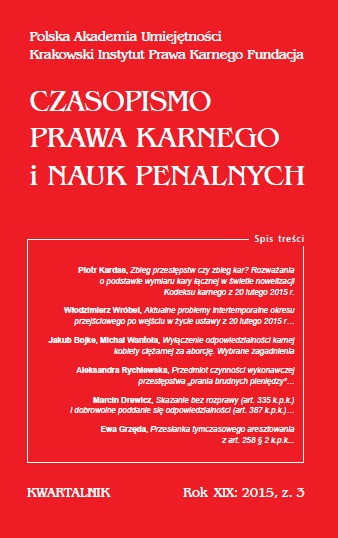Przedmiot czynności wykonawczej przestępstwa „prania brudnych pieniędzy”. Uwagi na tle uchwały Sądu Najwyższego z 18 grudnia 2013 r., I KZP 19/13
The element of a prohibited act describing an object of performed act of the „money laundering” crime – a few comments on the decision of the Supreme Court of 18 December 2013, I KZP 19/13
Author(s): Aleksandra RychlewskaSubject(s): Criminal Law
Published by: Polska Akademia Umiejętności / Krakowski Instytut Prawa Karnego Fundacja
Keywords: business transactions; money laundering; statutory interpretation; linguistic rules of interpretation
Summary/Abstract: Artykuł dotyczy interpretacji znamion czynu zabronionego z art. 299 § 1 k.k., w oparciu o językowe reguły wykładni tekstu prawnego. Spór wokół interpretacji znamienia przedmiotu czynności wykonawczej typu czynu zabronionego z art. 299 § 1 k.k. (środków majątkowych pochodzących z korzyści związanej z popełnieniem czynu zabronionego) sprowadza się do pytania, czy wyszczególnione środki majątkowe są tożsame z korzyścią, o której mowa w tym przepisie. Odpowiedź zależy od wykładni pojęcia „pochodzących”, łączącego środki majątkowe – które, zestawione ze znamieniem czynności wykonawczej, stanowią „brudne pieniądze” – z korzyścią z uprzednio popełnionego przestępstwa. Kontekst językowy terminu „pochodzenie” nie przesądza o istnieniu związku przyczynowego między dwoma rzeczami (pochodzącymi od siebie). Za „brudne pieniądze” mogą być uznane środki majątkowe będące częścią korzyści związanej (pośrednio lub bezpośrednio) z popełnieniem czynu zabronionego, jak i środki stanowiące substrat owej korzyści (wynikające z jej przetworzenia). Ferowana przez Sąd Najwyższy, szeroka wykładnia znamienia „brudnych pieniędzy” jest jednym z jego możliwych znaczeń językowych, a za jej wyborem przemawia odwołanie się do ratio legis przepisu w postaci ochrony obrotu gospodarczego. This paper concerns the topic of statutory interpretation, especially by using the linguistic rules, of the elements of a crime stated in art. 299 § 1 of the Criminal Code. Controversy regarding the interpretation of the element of a prohibited act describing an object of performed act of the „money laundering” crime specified in art. 299 § 1 of the Criminal Code (material benefits obtained from the benefits derived from a committed prohibited act) can be brought into question whether those material benefits are identical with the benefits derived from a committed prohibited act. The answer to this question depends on the interpretation of the term „obtained from”, which combines the specified material assets (the element of a prohibited act describing an object of performed act) with the benefits derived from a committed prohibited act. The context of term „obtained from” does not prejudge the existence of a causal relationship between two objects – the one obtained from the other. Material assets being the element of a prohibited act describing an object of performed act of a „money laundering” crime may be both the assets that are part of the (direct or indirect) benefit of the committed crime or the ones that result from processing of such assets. The interpretation preferred by the Supreme Court is not the only possible linguistic meaning of the used phrase. However, it is the right one as it corresponds with the ratio legis of the regulation, which is the protection of the business transactions.
Journal: Czasopismo Prawa Karnego i Nauk Penalnych
- Issue Year: 19/2015
- Issue No: 3
- Page Range: 105-116
- Page Count: 12
- Language: Polish

